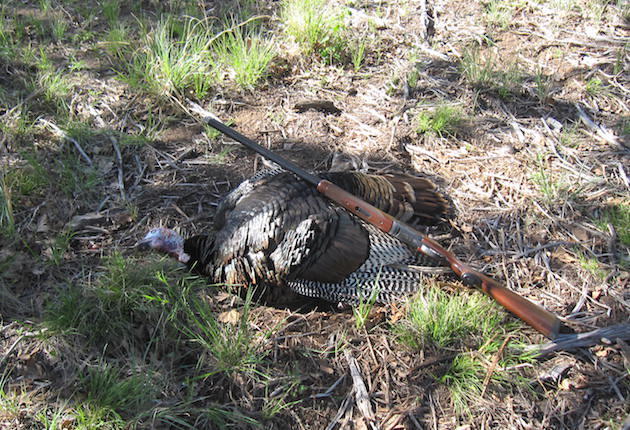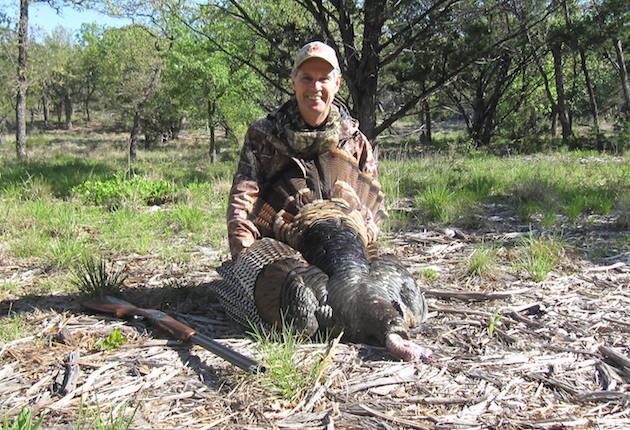The old tom snuck in. He did not gobble, did not go into strut, and did not hurry. He did not want competition for the affections of the hen that had to be nearby. He had bred with hens at first light, and was now cruising for those still needing his help to further their kind.
I first saw him at 55 yards. His angled path would take him within easy shotgun range, but as I looked to my left I realized he was not going to make it to me; Ken had seen him as well, and with his shotgun shouldered, was waiting for the tom to come clear.
I relaxed and watched. At the shot the tom crumpled and lay still. Ken’s smile was ear to ear, and with good reason — not only had he seen the tom early under adverse conditions and made an excellent shot, but the tom was huge — massive body and head, both spurs over an inch long, and a thick beard just over 10 inches in length.
Photos captured the moment forever. I could not help but think that I had taken few birds his equal, but was proud that I had called him in and happy to do so for a close friend.
Opening day, and what a day it was. It was just like opening day the year before when I had taken a large tom at almost this very spot, and at almost the exact same time of day.

The author didn’t get to kill this bird, but helping his friend bag it was just as good.
Spring turkey season is a special time for me. There are few endeavors more challenging than attempting to lure in an old tom, few animals more exciting to hunt than the wild turkey, and few places more beautiful than Texas in the spring. If there are spring rains, the land is green, new growth and wildflowers are everywhere, the temperatures mild, and the air filled with gobbles — with promise.
I vividly remember the first time an unseen tom gobbled close to me. It seemed as if his gobble shook the very leaves of the trees, and it caused my heart to leap, and then pound. So it remains today, a couple of decades later.
Opening day of 2015 fell on April 4. That day had an extra special start — a rare combination of a full moon, a super moon (look it up) and a total lunar eclipse, all of which occurred shortly before dawn. I was so enthralled that I was late getting away from camp, headed down to the creek bottom where I have had some success. I set the decoys and settled in nearby as the sky began to lighten.
Nothing. No gobbles, near or far. Then I glanced behind me and didn’t care, or at least as much. The sunrise was spectacular. It went on and on, different parts of the sky exploding in color, then fading as other quadrants of the sky took their turn. The setting was perfect; the beauty was breathtaking. As I watched the sunrise I was still listening closely for gobbles, but still heard nothing. Once the sun was up I called with zero response, nor was there the telltale movement of a tom sneaking in.
It was time for a “hike.”
In my experience, though the opening setup is your best bet, there are often opportunities to call in a fired-up gobbler after the initial breeding has taken place. I call them my “hikes” — no decoys for an elaborate setup, just me and my calls and shotgun, trolling for toms. I cover ground, listening for gobbles and looking for likely strutting areas with a decent tree. When either is located, I set up and call.
Hard lessons learned have taught me to actually get set up before calling. This day, you couldn’t ask for a better morning for a hike — we had just broken a three-year drought and spring was bursting forth with color and growth. I changed elevation, covered some ground, and called. Nothing.
The next setup was the same. I then found a great-looking area and a suitable tree. It looked like a perfect place to call for ranging toms after the initial breeding had been done. I carefully set up and called.
Nothing …
The heck with it. I took off my hat, head net, and gloves and just kicked back, enjoying the day but perplexed at not hearing any gobbles anywhere. I figured I would hang out there and listen for gobbles until lunch, then head back to camp.
After a few minutes, I pulled out my mouth call to practice, and yelped a few times. Immediately two gobblers hammered back, and close. I frantically tried to put on the items I had removed and hide the water bottle, which was tough to do while trying to minimize movement and remain silent. I slowly shifted to face the direction of the gobbles and yelped again. Again they hammered back immediately, this time even closer.
When I had shifted around I had taken a shooting position, and I was lucky I did, as the two gobblers appeared almost immediately. The nearest tom marched into a clearing and gobbled again, demanding the unseen hen come to him right now. I was hoping he would come closer, but something bothered him; perhaps he could hear my pounding heart, or I wasn’t successful in stopping my shaking.
He stood at full height and stared in my direction. After several seconds I decided he wasn’t coming closer, so I touched one off. He was 45 yards away, so I was fortunate that my go-to turkey gun is my beloved 3½-inch Beretta Onyx. He didn’t drop like Ken’s bird, but down he went. He wasn’t quite as big as Ken’s bird, either, but he was a very nice old tom.
It was 11 a.m., opening day. Perfection … at least until I discovered my camera was nowhere to be found. You will just have to trust me.


Enjoyed the article.